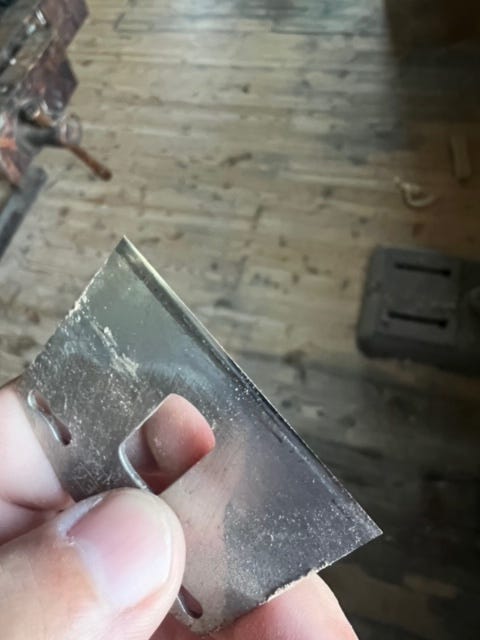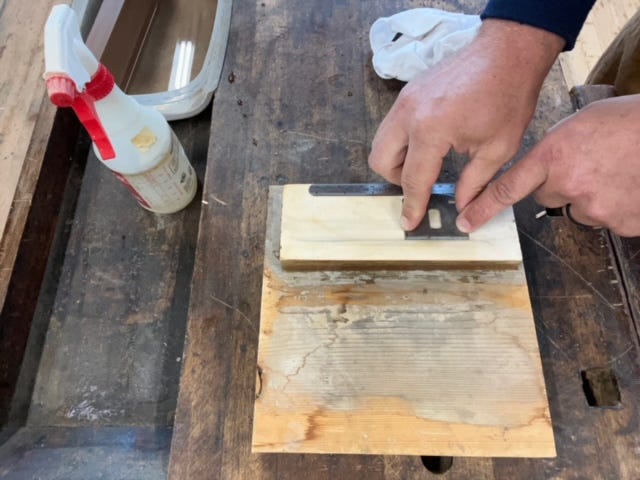I’m back from a couple weeks of classes. That means all the tools receive a tune-up before being put away. Whenever I teach, I’ll take all my applicable tools and we’ll share as necessary. They get used hard. I often find them piled together on a student benchtop - a combination square on top of a spokeshave on top of a drawknife, all in a pile of shavings. I cry a little inside, hope for the best, and put them in a safer space (one where the cutting edges aren’t touching other steel).
On Monday I had all my block planes and spokeshaves out for assessment. Nothing was amiss, only the standard dullness that comes with use. I set about returning things to sharp.
I changed my method of sharpening these tools after watching Deneb Puchalski of Lie Nielsen Toolworks share their recommended way of honing. My shop is a few miles for the Lie Nielsen. During classes in my space our group will often stop by for a demonstration or to use the hand tools within the showroom. Deneb gave a demo on sharpening earlier this spring, and in it he used the term “wear bevel,” a description I hadn’t heard before.
The wear bevel is the damage to the backside of the blade where it’s dulled and distorted from use. I see it most often on my block planes and spokeshaves (not as much on bench planes or other cutting edges). I don’t know why that is…possibly because I’ve had those tools in my hands most frequently over the past months.

The demonstration at Lie Nielsen advocated for the “ruler trick.” I believe it was originally shown and taught by furniture maker David Charlesworth (who demonstrates the ruler trick on a great YouTube video).
I’ve always avoided the ruler trick. My traditional training was built upon the flat backs of irons and blades. First step, make the flat back. Then, grind and hone the bevel at a desired angle. I’ve happily followed that approach the past 15 years or so. It isn’t broken so I haven’t considered fixing things. [Related - I’ve never been regarded as an early adopter.]
With all that said, I am open to new ways of sharpening, especially if it looks easier, faster, and more consistent than my current method. I listened to Deneb share why this method is preferable to free-hand sharpening (my current approach). And while I haven’t added the Lie Nielsen honing guide - I may get there some day - I have incorporated the ruler trick, along with free-hand honing.
A couple of notes:
I have incorporated the ruler trick when it will take too much time to return the back to flat. This happens after extended tools use without returning to the stones. Over the course of the summer, nearly all of my spokeshave and block plane blades have gone through the ruler trick since it is faster to add the back bevel than reflatten or grind past the damaged edge.
This isn’t an endorsement…I need to go about things for months (years?) before having a solid opinion on this method. But the early returns are promising; it takes less time to sharpen and I notice no difference (good or bad) in the quality of the edge.
I’ve made a commitment to this. It’ll take some doing to return the backs to flat or grind through the back bevel should I want to return to the flat back sharpening method.
Here’s the process I follow:
This is the first time this spokeshave blade is receiving the back bevel. I took it through the same honing process on all the waterstone grits; 1000 (brown), 4000 (white), and 8000 (yellow). Then I stropped the blade with leather/yellowstone.


And here’s the 8000 grit honing process. I took an extra pass or two, feeling for the burr, before stopping and stropping.
The finished picture shows the small back bevel at the cutting edge. I doubt the ruler trick method adds any durability, even at the (very slight) steeper cutting edge angle.
I’m happy to have a new sharpening method (don’t tell the craftspeople who trained me), one that is quick and easily repeatable. One of the knocks on free-hand sharpening is that there’s a long learning curve to competency. Yes, it’s extremely fast once the practitioner is proficient. But that often takes time. I appreciate that the Lie Nielsen approach shortens the time spent and skill needed to sharpen a cutting edge and get the woodworker back to making shavings.
My early results are good. Now if I could only return to the habit of honing at the end of each day…



Thanks Andy. I gave up that often tedious back flattening process on plane and spokeshave blades years ago after watching David Charlesworth’s video when first released ( may he rest in peace). Never use this technique on chisels which do require flat backs. I bought the LN honing guide when it was first released after trying several others, and for me the Lie Nielsen honing guide is the best one out there with great functionality and precision engineering . I can free hand sharpen just fine, but usually prefer to use my LN honing guide and the ruler trick. It only takes a 10 seconds or so to easily insert your blade into the guide using a homemade, preset angle guide stop.
Cheers,
Michael
The wear bevel shows up more on your block plane because it’s bevel up. The backside of the iron is what’s contacting the wood.
Schwarz explains this somewhere. I recently bought a woods and sons hollow auger and the wear bevel is immense on it, really highlighted the issue.